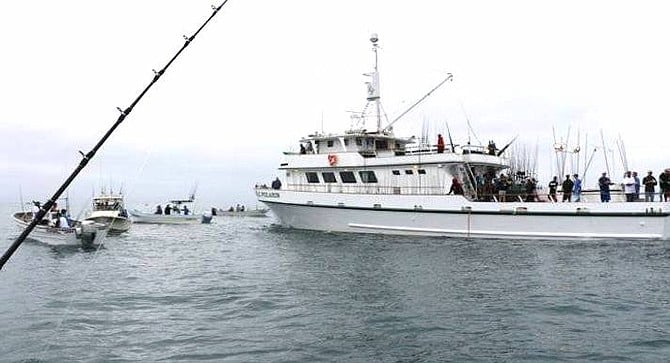 Facebook
Facebook
 X
X
 Instagram
Instagram
 TikTok
TikTok
 Youtube
Youtube

Last fall along Baja California’s Pacific coast, several San Diego-based sportfishing vessels were aggressively confronted by local pangeros.
The problem is, for the pangeros, the high spots that hold the endemic rockfish and draw the pelagic species as they migrate through the area are small volcanic sea mounts, in most cases rising to a pinpoint reef smaller than an average house. The boats that are fishing these mounts usually drift or troll on the outside so that all can access the bite zone. One of the confrontational hot spots was just offshore near San Quintin, about 200 miles south of San Diego.
The reefs in contention off San Quintin are a few dots along a stretch about 12 miles south of Isla San Martin and five to seven miles off the coast. San Diego sportboats fishing trips of three to five days or longer will often stop there to load up on reds, vermilions, and lingcod on their way home or when it is too rough outside, especially during hurricane season. The mid- to long-range sportboats carry an average of 25 to 30 anglers and are usually around 100 feet in length.
The largest local boats out of San Quintin are 25-foot Parkers with a capacity of four anglers. Pangas will carry two or three anglers. The average number of local vessels fishing those few high spots on a weekend during high season is four or five boats. The normal northwest winds pushing choppy seas keep the local anglers in their smaller craft from accessing those reefs a couple weeks out of each month, especially through winter/spring. Summer and fall are when the anglers along Baja California’s Pacific coast make hay.
When a large sportfishing vessel anchors on any one high spot, they block others from access. Last year’s confrontations were over just that; a few operators chose to pin up overnight on the local spots and did not pull their anchors when the local boats showed up in the morning. The fuss went all the way to Mexico City and the government sent delegates to San Quintin to hear complaints.
Considering both the pangeros’ plight and the delicate marine biosphere of the peninsula, the Pacific Islands Biosphere Reserve was created by the Mexican government and signed into law by the president of Mexico.
One of the main advocates for the biosphere reserve has been Wildcoast, founded in 2000 to protect the coasts of California and Latin America, led by the mayor of Imperial Beach, Serge Dedina.
For more information on Baja California and preservation efforts, Wildcoast invites you to Baja Bash On Saturday, June 10, 5:00 pm at the Coronado Cays Yacht Club to explore Baja California and the work to conserve the peninsula's beaches.


Last fall along Baja California’s Pacific coast, several San Diego-based sportfishing vessels were aggressively confronted by local pangeros.
The problem is, for the pangeros, the high spots that hold the endemic rockfish and draw the pelagic species as they migrate through the area are small volcanic sea mounts, in most cases rising to a pinpoint reef smaller than an average house. The boats that are fishing these mounts usually drift or troll on the outside so that all can access the bite zone. One of the confrontational hot spots was just offshore near San Quintin, about 200 miles south of San Diego.
The reefs in contention off San Quintin are a few dots along a stretch about 12 miles south of Isla San Martin and five to seven miles off the coast. San Diego sportboats fishing trips of three to five days or longer will often stop there to load up on reds, vermilions, and lingcod on their way home or when it is too rough outside, especially during hurricane season. The mid- to long-range sportboats carry an average of 25 to 30 anglers and are usually around 100 feet in length.
The largest local boats out of San Quintin are 25-foot Parkers with a capacity of four anglers. Pangas will carry two or three anglers. The average number of local vessels fishing those few high spots on a weekend during high season is four or five boats. The normal northwest winds pushing choppy seas keep the local anglers in their smaller craft from accessing those reefs a couple weeks out of each month, especially through winter/spring. Summer and fall are when the anglers along Baja California’s Pacific coast make hay.
When a large sportfishing vessel anchors on any one high spot, they block others from access. Last year’s confrontations were over just that; a few operators chose to pin up overnight on the local spots and did not pull their anchors when the local boats showed up in the morning. The fuss went all the way to Mexico City and the government sent delegates to San Quintin to hear complaints.
Considering both the pangeros’ plight and the delicate marine biosphere of the peninsula, the Pacific Islands Biosphere Reserve was created by the Mexican government and signed into law by the president of Mexico.
One of the main advocates for the biosphere reserve has been Wildcoast, founded in 2000 to protect the coasts of California and Latin America, led by the mayor of Imperial Beach, Serge Dedina.
For more information on Baja California and preservation efforts, Wildcoast invites you to Baja Bash On Saturday, June 10, 5:00 pm at the Coronado Cays Yacht Club to explore Baja California and the work to conserve the peninsula's beaches.
Comments